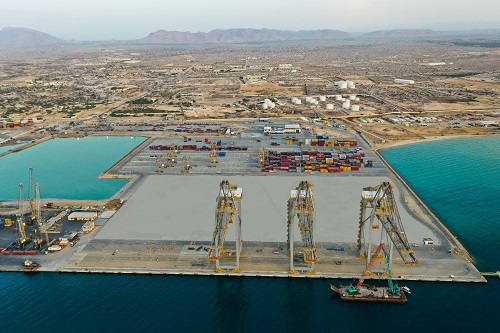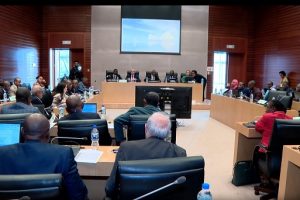
BY DARGIE KAHSAY
Ethiopia has proposed to enhance its import-export freight from the current 17 million tons to 32 million tons in its ten year economic plan. And 98 percent of the current import-export freight is transported through Djibouti ports, According to Ethiopian Transport Minister, Dagmawit Moges.
By making Djibouti ports Ethiopia’s major import-export transportation routines, Ethiopia is working to diversify port utilization for its ever growing import-export transaction.
During the past two months, two major developments were registered with the capacity of structural shift in port access and facilitation. In early May 2021, the first birth of the Lamu Port of Kenya, which is part of the Lamu Port South Sudan – Ethiopia Transport (LAPSSET) Corridor Project, a joint economic corridor project of Ethiopia, Kenya and South Sudan.
On the other hand, last week, the first phase expansion of Barbara port container terminal was inaugurated with modern technological installations with the capacity of accommodating one million TEUs (Twenty-foot Equivalent Unit) annually. Expansion of Barbara Port is being underway aiming at developing Barbara Corridor to transform Barbara into an integrated maritime, industrial and logistics hub in the Horn of Africa while Lamu Port is part of the LAPSSET Corridor program, East Africa’s largest and most ambitious infrastructure project bringing together Kenya, Ethiopia and South Sudan.
The Barbara Port expansion is being developed by the joint agreement of Ethiopia, Somali Land and DP World, with the shares of 19, 30 and 51 percent respectively. DP World has stated that the overall plan of Barbara Port expansion development is to link with DP World’s Jebel Ali Free Zone in Dubai, the economic zone, strategically located along the Barbara to Wajaala road (Barbara Corridor), as learnt from its website.
The Barbara economic zone will serve as a centre of trade in the region with the aim to attract investment and will target a range of industries, including warehousing, logistics, traders, manufacturers and other related sectors, DP World has specified.
DP World has further disclosed that the Barbara Corridor road upgrade project is being under construction to link to the existing modern highway on the Ethiopian side and position Barbara as a direct, safe and efficient trade route for Ethiopian transit cargo.
In addition, during the inauguration of the first expansion phase of Barbara Port Terminal, construction of the second phase expansion was launched to develop the port into a significant world class center of trade by increasing the capacity of the terminal to two million TEUs a year.
The LAPSSET Corridor Program launched on March 2012, to create an economic corridor between Ethiopia, Kenya and South Sudan using the Lamu Port is showing substantial developments, the three countries announced this Monday while evaluating the major achievements of the project. This ambitious regional project intended to provide transport and logistics infrastructure aimed at creating seamless connectivity between the Eastern African Countries.
On the Monday discussion forum, Minister Dagmawit said that with 110 million populations, Ethiopia is the biggest landlocked country in the world adding that its fast growing economy needs exploiting its neighboring ports. So far, over 90 percent of Ethiopia’s freight transaction through Djibouti ports and the remaining 10 percent through Barbara Port and Port Sudan.
Ethiopia is a landlocked country that is found at the hub of the Horn region while its neighbors except South Sudan have strategic ports. With over 110 million population and fast growing economic development, Ethiopia’s import-export transaction is growing from time to time.
Due to this reason, in addition to Djibouti ports, Ethiopia is working to utilize its neighboring ports including maximizing the utilization of Port Sudan and Barbara and working to use Kenya and Eritrean ports. Ethiopia’s efforts of connecting itself with its neighboring have a crucial role in strengthening its relation with each state that is playing a key role in integrating the region beyond its economic values.
In the same token, Minister Dagmawit noted that LAPSSET contribution is beyond trade and economy as it is expected to facilitate social interaction and people-to-people relations among the countries of the region. It is beyond its regional value in economic and social integration and LAPSSET corridor has significant importance for Agenda 2063 of Integrated Africa and for the facilitation of Africa free trade area, which was commenced on January 2021.
As to her, LAPSSET is a great additional opportunity for Ethiopia and the Horn countries to provide faster and more efficient logistics, to strengthen existing relations and advance trade transaction between the peoples of the region.
“As Africa is moving to continental integration to improve the continent’s connectivity” Dagmawit stated adding that “regional and continental integration only realizes through infrastructural developments and the Horn of Africa’s current infrastructural developments will play their crucial role in this regard.”
Furthermore, Dagmawit, explained that to use its neighboring ports, Ethiopia is enormously investing on infrastructural networking with all its neighbors including highways, railways and expanding its eight dry ports. In addition, Ethiopia is constructing one stop service stations at borders as it inaugurated the Moyale one stop service, which is part of the LAPSSET project.
Equally, Cabinet Secretary for Kenya-East African Community and Regional Development, Adan Mohamed clarfied that unemployment, low intra-Africa trade, low level of industrialization and poor infrastructure remains Africa’s top challenges for economic integration. He added LAPSSET and other similar regional projects will play key role to solve these limitations of Africa.
He also agreed with Dagmawit that LAPSSET will boost regional integration, improve business climate within the region and beyond and will play its role in strengthening people-to-people and cultural integration beyond borders.
And Kenya is working to facilitate the construction of the project as it inaugurated the first birth of Lamu Port on May 2021, which is able to handle some of the biggest ships in the world with the capacity more than 12 thousand TEUs. Two other parts are expected to come in the coming October, 2021. Adam reiterated that on Kenya’s side tremendous progress has been made on core infrastructural development and has continued to do so.
Likewise, South Sudan’s Director for Budget at Ministry of Finance and Planning, Scopas Malak G. Buli on his part argued that regional projects like LAPSSET has great advantages in strengthening regional peace and integration. Realization of regional projects like LAPSSET will play substantial reduces in cost of commodities within states and stabilizes political situations. Such projects forced countries for close collaboration and to work together for decision making, this strengthens peaceful relation and cooperation of countries.
Similarly, UN Under Secretary-General and Executive Secretary of ECA, Vera Songwe also noted that regional projects are not only about infrastructure, it is not only connection of roads and ports, it is connecting peoples and cultures.
Correspondingly, African Union High Representative for Infrastructure, Raila Odinga during the LAPSSET discussion on his part stated that the dream of regional and continental integration become real through intra-state infrastructural development to realize Africa’s integration.
Alike with the other officials, Ethiopian Finance Minister Ahmed Shide argued that Barbara port will boost regional economic integration and will play crucial role for Ethiopia’s ever-growing import-export transaction.
These projects are constructing to exploit Ethiopia’s untapped economic potential and the countries are working closely for local and regional developments while Ethiopia, with its harmonious policy of common development and win-win approach, is working with all its neighbors.
Due to the Djibouti Ports, the relation of Ethio-Djibouti develops to multidimensional strategic level and their economic development is inseparable and interdependent. To facilitate the import-export transaction, Ethiopia and Djibouti interconnected through railway in addition to the road transport which is developing to expressways.
Therefore, port developments enhance Ethiopia’s dreams of connecting with all its neighbors through railways and developing the existing roads to expressways. These Ethiopia’s unwavering efforts and the expansion and the development of the Horn of African Ports: Lamu, Barbara, Tajhura and others are believed to play their roles in connecting the Horn of Africa through infrastructure. And infrastructural linkage would strengthen regional and continental integrations.
The Ethiopian Herald June 30/2021




